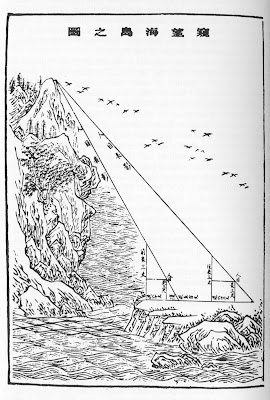
Triangulation is based on the side-angle-angle theorem: Knowing one side and two angles of a triangle determines the triangle completely (in practice, you can calculate the other two sides and the remaining angle).
Q:Now surveying a sea island, set up two three zhang poles at one thousand steps apart, let the two poles and the island in a straight line. Step back from the front post 123 steps, with eye on ground level, the tip of the pole is on a straight line with the peak of island. Step back 127 steps from the rear pole, eye on ground level also aligns with the tip of pole and tip of island. What is the height of the island, and what is the distance to the pole ?
By aligning the mountain top with the top of the pole, the surveyor determines the angle of the triangle in the picture at the vertex he is standing on (internal or external angle, either one determines the other). He does this for both vertices. Also, he knows the size of the base of the triangle, because he walked one thousand paces from one vertex of the base to the other (and his feet still hurt). So, the side-angle-angle theorem says that you can calculate all other sides and angles, and, in particular, you can know the height of the triangle, and that equals the height of the mountain.
The actual details of the calculation are not important for our purposes, because we will not be using triangulation to calculate anything, just to locate points by a mechanical and intuitive process that uses triangulation implicitly.
Oh, by the way, quoting Liu Hui again:
A: The height of the island is four li and 55 steps, and it is 120 li and 50 steps from the pole.
Sem comentários:
Enviar um comentário